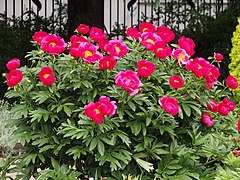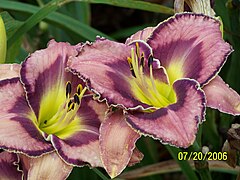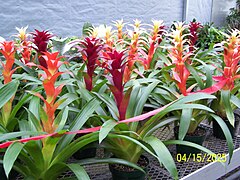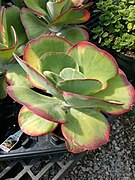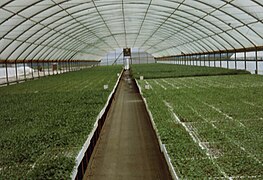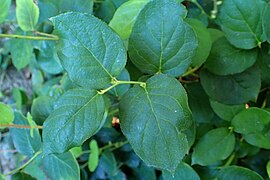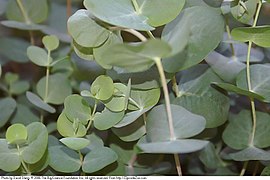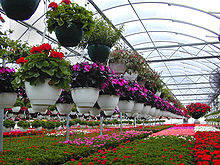

Floriculture is the study of the efficient production of the plants that produce showy, colorful flowers and foliage for human enjoyment and the human environment. It is a commercially successful branch of horticulture and agriculture found throughout the world. Efficient production practices have been developed over the years, for the hundreds of plant taxa used in the floral industry, increasing the overall knowledge of whole plant biology. Plant breeding and selection have produced tens of thousands of new genotypes for human use. Jasmine, marigold, chrysanthemum, rose, orchid, and anthurium are flowers of commercial demand.
Overview
[edit]Flowers are a part of human society. They are used at times of joy and sadness and part of everyday life. Flowers and plants may be indoors in a sunny window, as part of the landscape in the front yard or on the patio or deck in the back yard. People have been studying flowers and plants and their interaction with humans and how to produce these flowers and plants so all humans can enjoy them. Floriculture scientists throughout the world do this work.
Floriculture crops include cut flowers[1] and cut cultivated greens, bedding plants (garden flowers or annuals, and perennials, houseplants (foliage plants and flowering potted plants).[2][3] These plants are produced in ground beds, flower fields or in containers in a greenhouse. Protected cultivation is often used because these plants have a high value to humans.
Flower crops are grown in simple to highly sophisticated ways. These crops can be grown in soil in farm fields or in field soil in inexpensive high tunnel greenhouses.[4] For years, flowers were grown, seasonally for the specific crop, close to the market in Europe, North America and Asia. However, many crops of the floral industry have moved to a specific climate, typically in the mountains of South America, Africa and China, so certain plants can be grown year around[5] where hand labor is available.[6]
Protected horticulture (greenhouses) has developed simultaneously with the continued changes in the flower crops and markets. Floriculture is a major component of controlled-environment agriculture (CEA). Floriculture crops have a high value to humans, so the cost of an expensive production system - greenhouses,[7][8][9] automated environmental control, automated irrigation and fertilization, robotic seed, transplant and container handling, supplemental photosynthetic lighting - is necessary to produce these plants efficiently for the world-wide markets. Some are irrigated manually, but most are irrigated with drip irrigation, boom irrigation or flood floors. Hydroponics can be used for many cut flower crops.[7][9]
Floriculture value 2022
[edit]The global Floriculture market size is estimated to be worth US$50040 million in 2022 and is forecast to be a readjusted size of US$58030 million by 2028 with a compound annual growth rate of 2.5% during the review period.[10]
The total wholesale value of sales across all U.S. floriculture crops totaled US$6.69 billion in 2022 from 8,951 floriculture producers with a production area of 833 million square feet.[11]
Floriculture crops
[edit]-
Double flowered petunia - Petunia x atkinsiana
-
Geranium 'Multibloom' - Pelargonium x hortorum
-
Impatiens - Impatiens walleriana
-
Vinca - Catharanthus roseus
-
Moth Orchid - Phalaenopsis
-
Mums - Chrysanthemum x morifolium
-
Poinsettia 'Premium Red' - Euphorbia pulcherrima
-
Cyclamen - Cyclamen persicum
-
Hosta - Hosta
-
Peony - Paeonia lactiflora
-
Daylily - Hemerocallis fulva
-
Lenten rose - Helleborus
Foliage Plants, Indoor/Patio Use (Houseplants)
[edit]-
Guzmania - Guzmania lingulata
-
Rubber tree - Ficus elastica 'Doescheri'
-
Paddle plant - Kalanchoe luciae 'Flapjacks'
-
Croton - Codiaeum variegatum 'Petra'
Propagative Floriculture Materials
[edit]-
Transplants in greenhouse
-
Cucumber transplants ready for shipment
-
Hybrid tea rose 'Lady Diana' - Rosa
-
Snapdragon - Antirrhinum majus
-
Dahlia - Dahlia pinnata
-
Sunflower - Helianthus annuus
Cut Cultivated Greens
[edit]-
Leatherleaf fern - Rumohra adiantiformis
-
Salal - Gaultheria shallon
-
Silver dollar - Eucalyptus cinerea
-
Butcher's broom - Ruscus aculeatus
Floriculture advancements
[edit]Plant enthusiasts and growers learned significant details about growing certain plants over the years. Chrysanthemums have been cultivated in China for over 3000 years,[12] so growers knew about the plant and how to grow it. Floriculture scientists have simply continued this trend to control the plant's environment to control flowering for the significant dates when humans want flowers for celebrations and gatherings.
Photoperiodism
[edit]Chrysanthemum was one of the plants used in experiments that led to the definitions of photoperiod and photoperiodism.[13] Yet, it's likely that Chinese, Korean and Japanese plantsmen had a good understanding based on their years of experience. The occurrence of this physiological response and the reasons for it have been the subject of many experiments at universities and in industry.[14][15][16][17] Poinsettias are another short day plant with importance to flower growers.[18] These and additional experiments and experience have shown that temperature has an impact on the photoperiodic response.[19] Many cut flower and bedding plant species respond to long day or short day treatments for faster flowering.[20][21][22] The use of lighting treatments to extend the day and black cloth treatments to shorten the day are important additions to floriculture to increase the efficiency of plant production.
Plant tissue culture, micropropagation
[edit]Plant propagation has always been a part of flower and plant gardening. Plant tissue culture began as a way to save orchid embryos as orchid fanciers bred new cultivars. Most horticulture and many botany programs in the world had scientists working on plant propagation through tissue culture techniques from the 1950s to the 1980s.[23][24][25] These programs expanded the knowledge base on a wide range of taxa and allowed industry to find the connection to commercial production. Plant tissue culture allowed new, unique phenotypes and genotypes to be propagated in large numbers quickly. Many cultivars of foliage plants are available only from tissue culture.[26] Uniquely, tissue cultured geraniums were heat treated to allow the identification and removal of many viruses, virus-indexed.[27] As viruses were removed, many horticultural characteristics of the many cultivars disappeared; this led plant breeders to leave many viruses in breeding lines for future cultivars. Heat treatment of tissue culture of many taxa has since been used to remove bacteria and virus pathogens in various floriculture crops.
Containers and growing media
[edit]Containers of various kinds have been used in the culture of plants for a long time. Field soil or garden soil possibly with an addition of organic matter (compost) was placed in the container or pot and a plant was added followed by regular watering. It was simple but required experience and a watchful eye to prevent overwatering.
Most people don't recognize that this success was tied to a relatively deep pot, usually 6-10 inches (15–25 cm) deep or larger. Gravity was sufficient to pull or drain water from the soil so an adequate portion of the soil in the pot was well drained and oxygen would be available to the root system. As US greenhouses began to expand the bedding plant business in the 1950s and 1960s, they needed smaller containers for the logistical aspects of plant spacing and shipping. Vacuum formed plastic trays and packs offered the smaller sizes but composted field soil was easy to overwater in the smaller containers. The first step was to add peat moss and perlite to the field soil in a 1:1:1 ratio. The next step was to use other materials, sphagnum moss peat and vermiculite, in a 1:1 ratio, the Cornell peat-lite mix.[28][29] In the 1970s, more materials were used for growing media by the companies formed to process and distribute growing media to operations across the country. The physical properties of all the products had to be evaluated on a standard basis to make wise choices with economic decisions the operations were making.[30][31] As plug (young plant) production, mechanization of seed germination and mechanization of transplanting, began in the 1980s more work was necessary to manage the small volume of growing media in plug trays.[32] Research continues of all aspects of growing media and container design.[33]
The harvest and use of peat for growing media remains an environmental issue in North America and Europe.[34] Alternative and more sustainable materials continue to be added to growing media processing - pine bark, processed pine bark, coco coir, wood fiber, etc.[35][36] Sustainable solutions for growing media materials remain a high priority for the industry.[37]
Pesticide residues
[edit]Pesticide residues remain a significant issue for floriculture crops. Many countries have limited controls on pesticide usage but flower handlers and consumers could be contaminated by the residue.[38][39]
The impact of certain pesticides, neonics, on bees and other pollinators has become a significant concern. The application of these pesticides on garden flowers during greenhouse production can have a major impact on pollinator populations in a consumer's garden.[40][41]
Research continues on biological control of greenhouse insect, mite and plant pathogens to reduce pesticide use in floriculture crop production.[42][43][44]
Supplemental lighting
[edit]Supplemental lighting for flower crops began with photoperiod treatments and interest expanded to determine whether artificial light from electric lamps could substitute for sunlight during winter conditions.[45][46] Incandescent lamps were not successful, so floriculture had to wait for lighting technology to improve. Advancements with fluorescent lamps and industrial lamps (mercury vapor, high pressure sodium, low pressure sodium, etc.) led to improved plant production for geraniums, roses and other crops.[47][48][49][50] In the following decades, artificial lighting became standard practice in Europe, North America and Japan.[51]
Work was completed to standardize a plant's need for light (radiant energy) from natural and artificial sources. The term daily light integral (DLI) was introduced as a measurement of the optimal amount of radiant energy each plant requires for optimal growth.[52][53][54][55]
The introduction of light emitting diode (LED) lamps offered more opportunities for supplemental lighting. These lamps were more efficient at light production, cooler and allowed the manipulation of light quality from different wavelengths of light compared to other lamps.[56][57][58]
Supplemental lighting has been used to optimize production of seedlings,[59][60] bedding plants,[21] cut flowers[61] and other crops.
Plant nutrition, water quality and irrigation
[edit]Flower crops were grown in field soil like all horticultural and agricultural crops. Nutrients important to the flowers were held in the soil matrix and supplemented with additions of organic matter and animal manure. These organic additions were labor-intensive and inconsistent, reducing the ability to optimize flower production. Floriculture moved to growing media and inorganic fertilizer products in the 1950s and 1960s as container production became more important. This move was supported by hydroponic research more than soil science research. The "soil-less" nature of hydroponics was more similar to the "soil-less" nature of growing media.
See also
[edit]References
[edit]- ^ Armitage, Allan M (1993). Specialty cut flowers. The production of annuals, perennials, bulbs and woody plants for fresh and dried cut flowers. cabdirect.org.
- ^ Dole, John M; Wilkins, Harold F. (2004). Floriculture: Principles and Species (2nd ed.). Pearson.
- ^ Larson, Roy A (2013). Introduction to Floriculture. United States: Elsevier Science.
- ^ H. Chris Wien. Floral Crop Production in High Tunnels. HortTechnology Jan 2009 19(1): 56-60 doi:10.21273/HORTSCI.19.1.56
- ^ Van Rijswick C. World floriculture map 2015. Gearing Up for Stronger Competition, Rabobank Industry Note. 2015 Jan(475).
- ^ Harisha, BN (Oct 2017). "An economic analysis of floriculture in India". In Proceedings of the Sixth Middle East Conference on Global Business, Economics, Finance and Banking (ME17Dubai Conference): 6–8.
- ^ a b Hanan, Joe J (2017). Greenhouses: Advanced Technology for Protected Horticulture.
- ^ Hanan, J.J; Holley, W.D.; Goldsberry, K.L. (1978). Greenhouse Management. Advanced Series in Agricultural Sciences. Springer-Verlag.
- ^ a b Chris Beytes (Editor). 2021. Ball RedBook: Greenhouse Structures, Equipment, and Technology 19th Edition. Ball Publishing.
- ^ Floriculture Market 2022. Size, Share, Growth. Trends, Recent Developments, Company Profiles, Key Suppliers, Production Capacity, Revenue & Gross Margin, Market Drivers, Opportunities, Challenges and Forecast 2028. Market Reports World. April 04, 2022 07:48 ET.
- ^ 2022 Commercial Floriculture Survey NASS's Quick Stats. National Agricultural Statistics Service. United States Department of Agriculture. 05/31/2023.
- ^ Visitor Team at Manchester Museum (2020). "FOUR NOBLE PLANTS IN CHINESE CULTURE PART 4: CHRYSANTHEMUM, October 23, 2020".
- ^ Garner, W. and H. Allard. 1920. Effect of the relative length of day and night and other factors of the environment on growth and reproduction in plants. Jour. Agr. Res. 18:553-606.
- ^ Withrow, R.B. and H.M. Benedict. 1936. Photoperiodic responses of certain greenhouse annuals as influenced by intensity and wavelength of artificial light used to lengthen the daylight period. Plant Physiol. 11:225-249.
- ^ Popham, R. A., & Chan, A. P. (1952). Origin and development of the receptacle of Chrysanthemum morifolium. American Journal of Botany, 329-339.
- ^ Higuchi, Y., Sumitomo, K., Oda, A., Shimizu, H., & Hisamatsu, T. (2012). Day light quality affects the night-break response in the short-day plant chrysanthemum, suggesting differential phytochrome-mediated regulation of flowering. Journal of plant physiology, 169(18), 1789-1796.
- ^ Lee, B. J., Won, M. K., Choi, W. C., Yang, E. S., Lee, J. S., & Atherton, J. G. (2004). Floral development of chrysanthemum influenced by photoperiod. HORTICULTURE ENVIRONMENT and BIOTECHNOLOGY, 45(3), 149-153.
- ^ Parker, M. W., Borthwick, H. A., & Rappleye, L. E. (1950). Photoperiodic responses of poinsettia. Florists' Exchange, 115(20), 11-50.
- ^ Alden, M., & Faust, J. E. (2021). Unravelling the role of temperature and photoperiod on poinsettia heat delay. HortScience, 56(9), 1097-1103.
- ^ Harshitha, H. M., Chandrashekar, S. Y., & Harishkumar, K. (2021). Photoperiod manipulation in flowers and ornamentals for perpetual flowering. Pharma Innov J, 10(6), 127-134.
- ^ a b Erwin, J. E., & Warner, R. M. (2000, November). Determination of photoperiodic response group and effect of supplemental irradiance on flowering of several bedding plant species. In IV International ISHS Symposium on Artificial Lighting 580 (pp. 95-99).
- ^ Adams, S. R., & Langton, F. A. (2005). Photoperiod and plant growth: a review. The Journal of Horticultural Science and Biotechnology, 80(1), 2-10.
- ^ Thorpe, T. A. (2007). History of plant tissue culture. Molecular biotechnology, 37, 169-180.
- ^ Gamborg, O. L., Murashige, T., Thorpe, T. A., & Vasil, I. K. (1976). Plant tissue culture media. In vitro, 12(7), 473-478.
- ^ García-Gonzáles, R., Quiroz, K., Carrasco, B., & Caligari, P. (2010). Plant tissue culture: Current status, opportunities and challenges. International Journal of Agriculture and Natural Resources, 37(3), 5-30.
- ^ Griffith, L. P. (1998). Tropical Foliage Plants: A Grower's Guide. United States: Ball Pub.
- ^ Oglevee-O'Donovan, W. (1986). Production of culture virus-indexed geraniums. In Tissue culture as a plant production system for horticultural crops: Conference on Tissue Culture as a Plant Production System for Horticultural Crops, Beltsville, MD, October 20–23, 1985 (pp. 119-123). Dordrecht: Springer Netherlands.
- ^ Sheldrake Jr, R., & Boodley, J. W. (1965, May). Plant growing in lightweight artificial mixes. In Symposium on Vegetable Growing under Glass 4 (pp. 155-157).
- ^ Boodley, J. W., & Sheldrake, R. (1972). Cornell peat-lite mixes for commercial growing.
- ^ Bilderback, T. E., & Fonteno, W. C. (1987). Effects of container geometry and media physical properties on air and water volumes in containers. Journal of Environmental Horticulture, 5(4), 180-182.
- ^ Fonteno, W. C., Cassel, D. K., & Larson, R. A. (1981). Physical Properties of Three Container Media and their Effect on Poinsettia Growth1. Journal of the American Society for Horticultural Science, 106(6), 736-741.
- ^ Di Benedetto, A. H., & Klasman, R. (2004). The effect of plug cell volume on the post-transplant growth for Impatiens walleriana pot plant. European Journal of Horticultural Science, 69(2), 82-86.
- ^ Gallegos, J., Álvaro, J. E., & Urrestarazu, M. (2020). Container Design Affects Shoot and Root Growth of Vegetable Plant. HortScience horts, 55(6), 787-794. Retrieved Jul 22, 2023, from doi:10.21273/HORTSCI14954-20
- ^ Kitir, N., Yildirim, E., Şahin, Ü., Turan, M., Ekinci, M., Ors, S., ... & Ünlü, H. (2018). Peat use in horticulture. Peat; Topcuoglu, B., Turan, M., Eds.; IntechOpen: London, UK, 75-90.
- ^ Jackson B., Fields J., Altland J., Owen J. (2022). "The Latest on Growing Media Research Jan 1, 2022".
((cite web)): CS1 maint: multiple names: authors list (link) - ^ Eveleens, B., van Winkel, A., & Blok, C. (2021, August). Wood fiber in pot plant culture; peat replacement up to 50% in volume?. In II International Symposium on Growing Media, Soilless Cultivation, and Compost Utilization in Horticulture 1317 (pp. 165-174).
- ^ Barrett, G. E., Alexander, P. D., Robinson, J. S., & Bragg, N. C. (2016). Achieving environmentally sustainable growing media for soilless plant cultivation systems–A review. Scientia horticulturae, 212, 220-234.
- ^ Toumi, K., Vleminckx, C., Van Loco, J., Schiffers, B. 2016. Pesticide Residues on Three Cut Flower Species and Potential Exposure of Florists in Belgium.International Journal of Environmental Research and Public Health 13:943.
- ^ Pereira, P., Parente, C., Carvalho, G., Torres, J., Meire, R., Dorneles, P., Malm, O. (2021) A review on pesticides in flower production: A push to reduce human exposure and environmental contamination. Environmental Pollution, Volume 289:117817
- ^ Potts, S. G., Imperatriz-Fonseca, V., Ngo, H. T., Aizen, M. A., Biesmeijer, J. C., Breeze, T. D., ... & Vanbergen, A. J. (2016). Safeguarding pollinators and their values to human well-being. Nature, 540(7632), 220-229.
- ^ Thompson, D. A., Lehmler, H. J., Kolpin, D. W., Hladik, M. L., Vargo, J. D., Schilling, K. E., ... & Field, R. W. (2020). A critical review on the potential impacts of neonicotinoid insecticide use: current knowledge of environmental fate, toxicity, and implications for human health. Environmental Science: Processes & Impacts, 22(6), 1315-1346.
- ^ Messelink, G. J., & Janssen, A. (2014). Increased control of thrips and aphids in greenhouses with two species of generalist predatory bugs involved in intraguild predation. Biological Control, 79, 1-7.
- ^ van Lenteren, J. C. (2007). Biological control for insect pests in greenhouses: an unexpected success. Biological control: a global perspective. CAB Int, Wallingford, 105-117.
- ^ Van Driesche, R., & Hoddle, M. (2009). Control of pests and weeds by natural enemies: an introduction to biological control. John Wiley & Sons.
- ^ Werner, H. O. (1942). Relation of length of photoperiod and intensity of supplemental light to the production of flowers and berries in the greenhouse by several varieties of potatoes. Journal of Agricultural Research, 64, 257-275.
- ^ Ramaley, F. (1934). Influence of supplemental light on blooming. Botanical Gazette, 96(1), 165-174.
- ^ Carpenter, W. J., & Rodriguez, R. C. (1971). Earlier Flowering of Geranium cv. Carefree Scarlet by High Intensity Supplemental Light Treatment1. HortScience, 6(3), 206-207.
- ^ Armitage, A. M., & Tsujita, M. J. (1979). Supplemental lighting and nitrogen nutrition effects on yield and quality of Forever Yours roses. Canadian Journal of Plant Science, 59(2), 343-350.
- ^ Cathey, H. M., & Campbell, L. E. (1979). Relative Efficiency of High-and Low-pressure Sodium and Incandescent Filament Lamps Used to Supplement Natural Winter Light in Greenhouses1. Journal of the American Society for Horticultural Science, 104(6), 812-825.
- ^ Lee, M.J., Seo, H.S., Min, S.Y., Lee, J., Park, S., Jeon, J.B., Kim, J. and Oh, W., 2021. Effects of supplemental lighting with high-pressure sodium or plasma lamps on quality and yield of cut roses. Horticultural Science and Technology, 39(1), pp.49-61.
- ^ Moe, R., Grimstad, S. O., & Gislerod, H. R. (2005, June). The use of artificial light in year round production of greenhouse crops in Norway. In V International Symposium on Artificial Lighting in Horticulture 711 (pp. 35-42).
- ^ Faust, J. E., Holcombe, V., Rajapakse, N. C., & Layne, D. R. (2005). The effect of daily light integral on bedding plant growth and flowering. HortScience, 40(3), 645-649.
- ^ Kjaer, K. H., Ottosen, C. O., & Jørgensen, B. N. (2012). Timing growth and development of Campanula by daily light integral and supplemental light level in a cost-efficient light control system. Scientia Horticulturae, 143, 189-196.
- ^ Faust, J. E., & Logan, J. (2018). Daily light integral: A research review and high-resolution maps of the United States. HortScience, 53(9), 1250-1257.
- ^ Oh, W., Cheon, I. H., Kim, K. S., & Runkle, E. S. (2009). Photosynthetic daily light integral influences flowering time and crop characteristics of Cyclamen persicum. HortScience, 44(2), 341-344.
- ^ Mitchell, C. A., Both, A. J., Bourget, C. M., Burr, J. F., Kubota, C., Lopez, R. G., ... & Runkle, E. S. (2012). LEDs: The future of greenhouse lighting!. Chronica Horticulturae, 52(1), 6-12.
- ^ Jeong, S.W., Hogewoning, S.W. and van Ieperen, W., 2014. Responses of supplemental blue light on flowering and stem extension growth of cut chrysanthemum. Scientia Horticulturae, 165, pp.69-74.
- ^ Kobori, M. M. R. G., da Costa Mello, S., de Freitas, I. S., Silveira, F. F., Alves, M. C., & Azevedo, R. A. (2022). Supplemental light with different blue and red ratios in the physiology, yield and quality of Impatiens. Scientia Horticulturae, 306, 111424.
- ^ Oh, W., Runkle, E. S., & Warner, R. M. (2010). Timing and duration of supplemental lighting during the seedling stage influence quality and flowering in petunia and pansy. HortScience, 45(9), 1332-1337.
- ^ Randall, W. C., & Lopez, R. G. (2015). Comparison of bedding plant seedlings grown under sole-source light-emitting diodes (LEDs) and greenhouse supplemental lighting from LEDs and high-pressure sodium lamps. HortScience, 50(5), 705-713.
- ^ Spall, C. E., & Lopez, R. G. (2023). Supplemental Lighting Quality Influences Time to Flower and Finished Quality of Three Long-Day Specialty Cut Flowers. Horticulturae, 9(1), 73.
Further reading
[edit]- USDA - National Agricultural Statistics Service Floriculture Crops
- University of Florida
- California Cut Flower Commission
- North Carolina State University Floriculture Information Center
- https://www.researchgate.net/publication/295862115_Diversification_Through_Floriculture_in_Kashmir_Valley
External links
[edit]- Cut Flowers and Greens Growers at Curlie
- . Encyclopædia Britannica (11th ed.). 1911.
| Subdisciplines | |||||||||||
|---|---|---|---|---|---|---|---|---|---|---|---|
| Plant groups | |||||||||||
| Plant anatomy |
| ||||||||||
| Plant physiology Materials | |||||||||||
| Plant growth and habit | |||||||||||
| Reproduction | |||||||||||
| Plant taxonomy | |||||||||||
| Practice | |||||||||||
| |||||||||||









